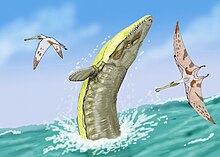Dakosaurus
| Dakosaurus | ||||||||||||
|---|---|---|---|---|---|---|---|---|---|---|---|---|

Skull of Dakosaurus maximus in the Museum für Naturkunde Stuttgart |
||||||||||||
| Temporal occurrence | ||||||||||||
| Upper Jurassic to Lower Cretaceous | ||||||||||||
| 155.7 to 112 million years | ||||||||||||
| Locations | ||||||||||||
| Systematics | ||||||||||||
|
||||||||||||
| Scientific name | ||||||||||||
| Dakosaurus | ||||||||||||
| Quenstedt , 1856 | ||||||||||||
| species | ||||||||||||
|
Dakosaurus was a marine representative of the crocodiles with an unusually short snout, who lived from the Middle Upper Jurassic ( Kimmeridgian ) to the Lower Cretaceous ( Aptian ). Fossils have been found in Europe and Argentina.
Discovery and first description
The genus was established in 1856 by Friedrich August von Quenstedt on the basis of an isolated tooth previously described by Plieninger as Geosaurus maximus .
The largest of the two valid species, Dakosaurus andiniensis , was found in 1996 by students at the Universidad de Buenos Aires in the Argentine part of Patagonia. Among them was a fully preserved fossil skull. The scientists involved in the investigation gave the find the nickname " Godzilla " because of its unusually short snout for a crocodile . In 2006 he was scientifically described in the journal Science by the paleontologist Zulma Gasparini of the Universidad Nacional de La Plata as well as D. Pol and LA Spalletti .
From dakosaurus andiniensis three individuals were found in total, one on farmland in the province of Mendoza , two more in a rock formation of the Province of Neuquen . This region was once flooded by the Pacific Ocean .
description

In D. andiniensis it was a purely marine animal. The main difference between the species and its ancestors is the shape of the massive skull, which is more reminiscent of a carnivorous dinosaur like Tyrannosaurus rex than of other crocodiles. The jaw was one meter long and had pointed teeth up to 10 cm long.
The skull and teeth indicate that D. andiniensis , in contrast to relatives living at the same time, did not (or hardly) hunt fish, but rather marine reptiles such as ichthyosaurs and other large marine life. In his way of life he was more like other large prey-hunting sea creatures such as the great white shark or the orca .
D. andiniensis was up to six meters long. In contrast to the recent crocodiles , his feet were transformed into paddle-like fins, which were probably used for stability when swimming. The tail provided the drive.
literature
- Zulma Gasparini, Diego Pol, Luis A. Spalletti: An Unusual Marine Crocodyliform from the Jurassic-Cretaceous Boundary of Patagonia. In: Science . Vol. 311, No. 5757, 2006, pp. 70–73, doi : 10.1126 / science.1120803 , E-Text (PDF; 860 kB) .
Web links
- The Paleobiology Database Dakosaurus
- Telepolis report Godzilla was a crocodile (German)
- National Geographic - "Godzilla" Fossils Reveal Real-Life Sea Monster (English)
